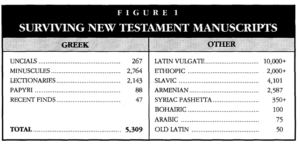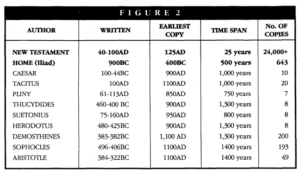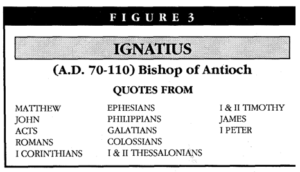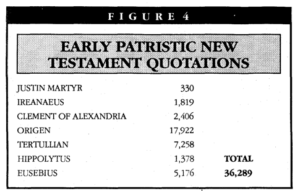In the articles which have appeared previously, we have examined the evidence external to the New Testament which lends support to our belief in the existence of Jesus Christ as a man of history. However, by so doing, we have left untouched the greatest evidence of all, this of course being the New Testament itself. This article deals with a few of the many powerful proofs which arise from God’s inspired account of His son’s life, as well as a few helpful and interesting facts which give us great confidence in the New Testament as an accurate and true record.
As we have discovered in our previous articles, it is relatively easy to prove that Jesus is a man of history. The problem arises in trying to convince people that Jesus was actually the Son of God, and that he performed the miracles that the new Testament claims he did; and above all, it is immensely difficult to persuade people that Jesus rose from the dead. This difficulty lies not in providing unassailable evidence, but rather is due to the moral obligations which it imposes upon the individual1. It would appear that it is for this reason that the majority of people choose to reject the New Testament account of the life of Jesus.
Is the New Testament Reliable?
Before anyone will accept the New Testament’s claim about Jesus, it is not unreasonable for them to wish to ascertain its reliability as an historical document. Many people are under the false impression that it is an unreliable collection of writings which have been modified and tampered with over the centuries, and hence cannot be trusted. Let us attempt to dispel that notion with a few facts.
The first thing that needs clarification is the difference between proving the Bible’s reliability and its inspiration. For most non-believers, it is essential that reliability is proved before inspiration can be accepted. The question of reliability revolves around the questions: ‘Is the New Testament we have today the same as the original writings of approximately 1900 years ago?’ So, what we are testing here is the historical reliability of the scriptures, and it is to this we will now turn our attention.
The Bibliographical Test
When testing the historical reliability of the New Testament, it is important that we are fair (i.e. that we apply the same tests to it as we would to any other historical document). One of the best and most widely recognised tests is the ‘bibliographical test’. This is an examination of the textual transmission by which documents reach us. In other words, since we don’t have the original documents, how reliable are the copies we have in regard to (a) the number of manuscripts, and (b) the time interval between the original and the extant copy.
(a) The Number of Manuscripts
It is a well known and acknowledged fact that the New Testament is the most widely circulated and frequently copied book of antiquity. On numbers alone, the New Testament is a clear winner, and this is a point which is of considerable importance. Figure 1 shows a breakdown of the manuscripts which are available today. There are more than 5,300 known Greek manuscripts of the New Testament. Add to this over 10,000 Latin Vulgate and at least 9,300 other early versions and we have more than 24,000 manuscript copies of portions of the New Testament in existence today.
No other document of antiquity comes anywhere near this. In fact, Homer’s Tliad’is the next most prolific, with only 643 manuscripts that still survive (see Figure 2). A glance down the last column of the chart shows the paltry number of copies extant for some of the more famous authors of antiquity — yet the reliability of these documents is accepted much more readily than the New Testament!

(b) The Time Interval
The religious sceptic often takes delight in pointing out that we do not possess the original documents of the New Testament, and the consequent conclusion is that we cannot be sure that the Bible we have today is accurate or reliable.
However, we need to be equally aware that we don’t have the original documents of any of the ancient writings which are readily accepted. These other historical works which are accepted without question are only copies, and are often rather remote from the original manuscript. Reference to Figure 2 again gives us the rather surprising information that the average time span from the original document to the earliest known copy extant is about 1,000 years!
Homer’s ‘Iliad’ is again the best example that can be mustered from the ancient writers, there being only a 500 year time span. Once again, the New Testament compares more than favourably with this, with a mere 25 to 30 time span between its being penned, and the earliest fragment available.2
While we are comparing the Iliad with the New Testament, the following quotation is also very enlightening.
“Both it (the Iliad) and the Bible were considered ‘sacred’ … The New Testament has about 20,000 lines, the Iliad 15,600. Only 40 lines (400 words) of the New Testament are in doubt whereas 764 lines of the Iliad are questioned. This 5% textual corruption compares with 0.5% of similar emendations in the New Testament. The national epic of India, the Mahabharata, has suffered even more corruption. It is about eight times the size of the Iliad and Odyssey together — roughly 250,000 lines. Of these, some 26,000 lines are textual corruptions (10%). ” 3
Once again, the New Testament is a clear winner!

Let us now pursue this whole question from a slightly different angle. We are now going to see how that the early church fathers provide us with another proof of the accuracy of the New Testament.
These church fathers actually give a witness to the text which we have, because of the very interesting fact that it is quite possible to reconstruct the New Testament from their quotations of it alone. A prime example is Ignatius (AD 70-110) who was Bishop of Antioch. He knew well the apostles of Jesus, and he himself wrote seven (uninspired) epistles. Figure 3 shows the New Testament writers that he quotes from, and his early date of writing certainly puts to rest the argument that the majority of the New Testament is a fabrication stretching over hundreds of years.
Of course, Ignatius was not the only one. Figure 4 lists some of the better known church fathers that lived prior to AD 300, and indicates the number of New Testament quotations they make.
Note that there are over 36,000 independent quotations — a vast amount by anyone’s standards! It is also interesting to note that another researcher 4
who has studied these early patriotic quotations, has found that the entire New Testament (except 11 verses) can be reconstructed from them.
The preceding comments simply serve to show that the new Testament is a reliable document which has many external proofs to back it up. We have really only scratched the surface of just a few of these.
Internal Evidence
It is commonly asserted that the New Testament cannot be trusted in its entirety because, amongst other things, it makes claims which are outside the experience of most people. These include the miracles reported in the Gospels and The Acts, and the greatest stumbling block of all is the resurrection of Jesus. Now, if we decide that we will accept some of the things that are recorded, but we can’t believe that Jesus rose from the dead, this leads us to one of two conclusions:
- The New Testament writers were lying in what they wrote; or
- They were mistaken about the identity of the man (Jesus).
There would appear to be no other way around the problem. We have already demonstrated that the New Testament is accurate, (i.e. that the one we possess today is the same as the original documents) so let us now address these two questions.
1. Were The New Testament Writers Mistaken About The Identity Of Jesus?
Consider the improbability of this proposition. The disciples of Jesus had spent about three and a half years in daily company with their master. They knew him intimately; they knew his physical appearance, they knew his voice, they knew his mannerisms. They then saw this man put to death. They found this very difficult to accept, but they saw it happen and thus were forced to accept it. They were very deflated and thought that this would be the end of him. However, much to their surprise, three days after this man was crucified, they saw him alive. They spoke with him. They touched him. They shared his company on several occasions over the next 40 days. Could there be any mistake that this was the same man? Could his close friends of three and a half years be mistaken about his identity? This line of reasoning will usually cause an honest mind to admit the improbability (if not the impossibility) of the situation.
2. Were the New Testament Writers Lying?
The only option left to the non-believer in the New Testament is to assert that the writers fabricated the story about the resurrection of Jesus. A variety of reasons and motives are attributed to them, none of which are logical or can be validated, and in fact it is much more easily demonstrated that:
- The New Testament writers did not lie.
- They would have been laughed to scorn in their own day if they had been lying.
- It would have been foolish and illogical for them to have fabricated their testimonies about the resurrection of Jesus.
Taking these points one at a time:
1. If there were, for example, a car accident and there were a number of independent eye witnesses to that accident, all of whom gave the same testimony about that accident, would we who were not present at the scene, have any reason to doubt their testimony? Would we say they were lying? The question begs the answer ‘no’. Why, then, don’t people attribute the same integrity to the witnesses of the greatest event of human history? Consider the following selection of quotations:
“We have not followed cunningly devised fables … but were eye-witnesses of his majesty” II Peter 1:16.
“This Jesus God bath raised up, whereof we all are witnesses”.Acts 2:32.
“(Him) God bath raised from the dead, whereof we are witnesses”. Acts 3:15.
“To whom (his disciples) Christ showed himself alive after his sufferings, by many infallible proofs being seen of forty days”
Other quotations such as Acts 4:19; 5:29; 10:39 are a few more examples of similarly strong testimony, not to mention the accounts of the gospel writers themselves. There is no valid reason to doubt this corroborative evidence. 5

2. If these men were lying about the resurrection of Jesus, they would have been laughed to scorn in their own day. Consider these words which the apostle Paul wrote in I Corinthians 15:4-8
“And that he was buried, and that he rose again the third day according to the scriptures: And that he was seen of Cephas, then of the twelve: After that he was seen of above five hundred brethren at once; of whom the greater part remain unto this present, but some are fallen asleep. After that, he was seen flames; then of all the apostles. And last of all he was seen of me also, as of one born out of due time.”
Now, if Jesus hadn’t been raised, Paul would have been laughed to scorn. Apart from the other statements that he makes here, he says that over 500 people saw the resurrected Jesus at one time, most of whom were still alive at the time Paul was writing this epistle. The very fact that Paul was able to write this with total impunity is a clear indication of the truth of his statement.

3. If these followers of Jesus were lying about the resurrection of Jesus, then they were particularly stupid men. Would sane men have suffered torture, shipwreck, loss of all personal wealth, and even death, if they only thought that Jesus had risen from the dead? How many people would be prepared to suffer any of these hardships, simply for a story which they had invented — or a vague belief which they entertained? As Paul indicates in Philippians 3:8, there was no material advantage in his believing in the resurrected Jesus. “I count all things loss for the excellency of the knowledge of Christ Jesus my Lord; for whom I have suffered the loss of all things, and do count them but dung, that I may win Christ.”
Also, the account which Paul gives in II Corinthians 11:23-28, concerning the sufferings which he underwent, is obviously written by a man who was totally convinced of the resurrected Jesus. Would Paul and the other believers have suffered all these things if they were not certain? Paul was an eyewitness of the resurrected Jesus. Do we have any reasonable grounds to doubt him?
As the Apostle Paul states in such a pithy way “… Christ be not raised, your faith is vain … It is hoped that these few thoughts might help us toward that confidence of mind which allowed Job to express, “I know that my redeemer liveth and that he shall stand at the latter day upon the earth. “Job 19:25.
- Forrest Brinkerhoff has shown that a similar problem is encountered in the creation/ evolution debate. See Maranatha’, Volume 1, No. 5, (Spring, 1988), pp.113-115 (ed.)
- John Rylands’ MS (130 AD) is located in the John Rylands Library of Manchester, England (oldest extant fragment of the New Testament — a portion of the Gospel of John).
- Geisler, Norman L. and William E. Nix. A General Introduction To The Bible. Chicago: Moody Press, 1968, pp. 366-367.
- Leach, Charles. Our Bible. How We Got It. Chicago: Moody Press, 1898, pp. 35-36.
- I Corinthians 15:17
